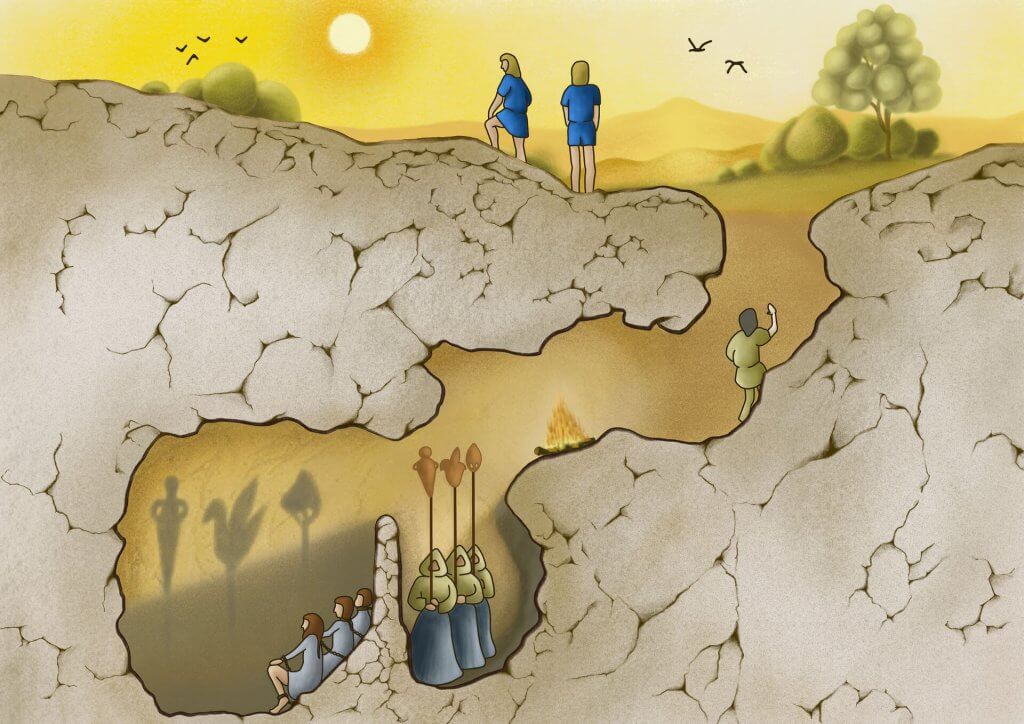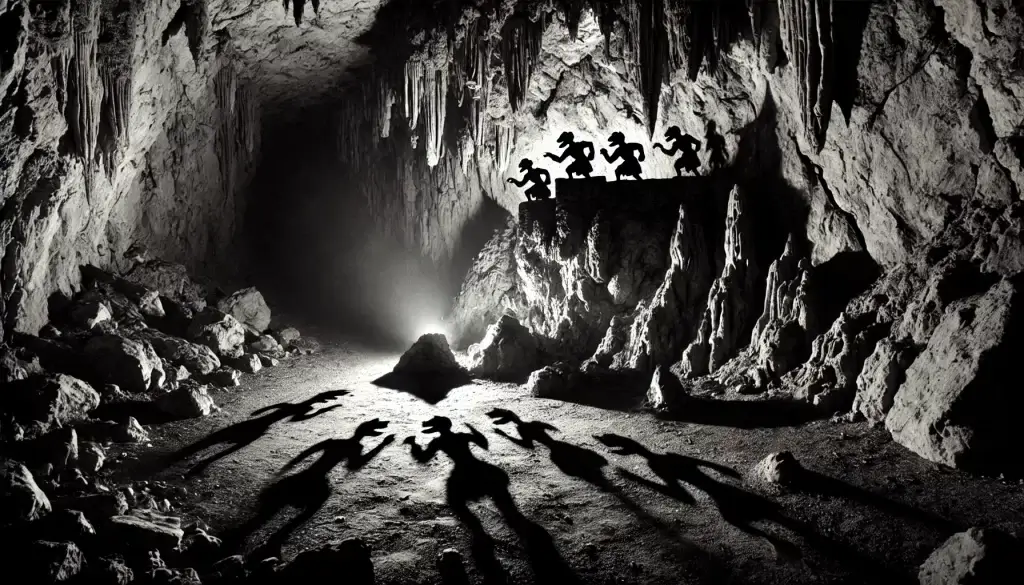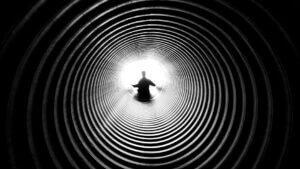Plato’s Cave- Why The Allegory Of The Cave Still Matters
Audio PlayerEver feel like the world around you isn’t quite what it seems? Like you’re seeing only part of the picture, but you’re not sure what’s missing? In this time of social media and AI-generated content, many of us are trapped in cycles of information that may not reflect reality.
And it’s not just the external world either. Our internal one can often be the same, with habits and mindsets that don’t really take us towards the kind of life we want, or toward being the kind of person we might want to be deep down.
This feeling of being confined to a limited perspective isn’t new. Over 2,000 years ago, the ancient Greek philosopher, Plato, told a story about prisoners in a cave, mistaking shadows for reality. When one prisoner broke free and saw the real world, they realized how narrow their perception had been. Yet, when they returned to the cave to share their newfound truth, the other prisoners rejected them.
If you have ever watched movies like The Matrix or The Truman Show, you will recognise the themes and parallels with Plato’s Cave. Plato’s allegory has had a profound impact in many areas like science, literature and art.
And Plato’s Allegory of the Cave is now more relevant than ever, especially in this modern world of bullshit. It’s not just a story about society’s resistance to truth but about our personal limitations, like how we get stuck in our own mental caves, mistaking our own thoughts and fears for reality.
And as someone who helps people navigate their own “caves,” I see it as both a warning and a quiet nudge toward something brighter. And it might be just what the world needs right now.

The Allegory of the Cave
Imagine a group of people chained in a dark cave since birth. Even their necks are shackled so that they cannot look left or right. They face a blank wall, and behind them is a raised fire casting shadows of moving objects.
The shadows are cast by the ‘puppeteers’ who hold various objects on poles so that they cast the shadow onto the wall the prisoners see.
These prisoners can’t see the real objects – only their shadows on the wall. To the prisoners, those shadows are reality, they are dancing shapes they name, argue over, and build their lives around.
Then, one prisoner is freed. He turns around, sees the fire and the real objects, and eventually ventures outside the cave. At first, the sunlight blinds him, it’s painful and hard, but soon he starts to see colors, depth, and true reality. Overwhelmed, he returns to the cave to share what he’s discovered. As he does so however, the others refuse to believe him, clinging to the familiar shadows on the wall. They even threaten him with violence for trying to break their version of ‘truth’.
Plato’s original intent was to illustrate how humans resist enlightenment when it challenges their existing beliefs. He thought education was the way out of this predicament- and this can be seen from the original Latin origins of the word: educere (from ex- “out” + ducere “to lead”), which means “to lead out” or “to draw forth.” So in a sense – to lead out into the light.
Let’s be honest though, it’s not just an old story, we’re all a little like those prisoners, mistaking what we see for the whole truth. And today our caves are louder, shinier, and trickier to escape than ever.

Modern Puppeteers – The Media, AI, and Information Control
Today, our caves are more complex. We’re bombarded with information 24/7, much of it curated by algorithms or mass media conglomerates, designed to show us content that shapes our beliefs. These algorithms and mass media act as modern puppeteers, controlling what we see and how we think.
AI-generated content will further blur the line between reality and illusion, making it even harder to discern truth from shadow.
It even comes down to the forms and types of media used to convey information. Like whether we read, watch or listen, or whether it’s short form or long form content. And as Niel Postman says in his book Amusing Ourselves to Death; “The media available to a culture are a dominant influence on the formation of its ideas of truth.”
Also consider how social media influences our perception of the world. The content we engage with is shaped by algorithms that reinforce or manipulate our biases. This creates echo chambers where our views are never challenged, and alternative perspectives are filtered out. Similarly, news cycles often prioritize sensationalism or alarmism over accuracy and objectivity, shaping public opinion based on engagement metrics rather than truth.
And the scary part? Most of us don’t even realize we’re watching shadows! We accept the curated reality presented to us without question. But what happens when someone steps out of this cave – when they start questioning, seeking truth, and breaking away from automated thinking?
Often, the response is resistance and rejection in one way or another. Those still in the cave may ridicule or dismiss them, just as the prisoners in Plato’s story did. It’s easier to stay in the cave than to face the discomfort of uncertainty. But understanding this resistance is the first step in overcoming it.
This brings us to a deeper question: What if the cave isn’t just an external structure built by society? What if it’s also internal and crafted by our own minds?

The Cave as a Metaphor for Our Own Psychological Limitations
Plato’s Cave isn’t just a societal critique; it’s a profound metaphor for our own minds. We all have internal caves, like limiting beliefs, fears, and conditioned patterns of thinking that shape our perception of reality.
These internal shadows might be thoughts like “I’m not good enough,” “I can’t change,” or “This is just the way things are.” We often mistake these automatic thoughts for truth, confining ourselves to a narrow perspective. Our own mental cave becomes a prison, keeping us stuck in familiar but unhelpful patterns.
This mental imprisonment is often reinforced by past experiences, upbringing, social conditioning, or even just the fundamental way our minds work. From an early age, we are taught certain “truths” about success, relationships, and personal worth. These messages become ingrained, shaping our sense of identity and potential. Just like the prisoners in the cave, we struggle to look beyond what we’ve always known. The moment we start noticing these narratives, the discomfort sets in, just as the freed prisoner struggled with the blinding sunlight of reality.
Psychological flexibility, the ability to adapt and shift our perspective, attention, and take action in alignment with our values, is a big key to escaping this cave. But stepping out isn’t easy. It requires us to confront uncertainty, observe our beliefs, and be willing to experience discomfort. Our minds naturally resist this process, preferring the safety of the known shadows.
However, personal transformation doesn’t happen by merely “thinking” our way out of limiting beliefs – it requires action! Engaging with new perspectives, putting ourselves in unfamiliar situations, and allowing ourselves to sit with discomfort are all crucial to expanding our understanding of reality. When we avoid these experiences, we reinforce the illusion of the cave, making it harder to escape.

How to Escape Your Own Cave
Escaping the cave isn’t about sudden enlightenment; it’s a process of gradual awakening and awareness. It’s about developing the skills to observe your thoughts, shift your attention, and take action aligned with your values rather than your fears.
Here’s how you can start the process:
- Notice Your Shadows:
- Instead of struggling with or challenging thoughts, recognize them for what they are – mental events, not absolute truths of reality. Ask yourself, “Is this a helpful story my mind is telling me?”
- Shift from Autopilot to Flexible Attention:
- Notice where your mind goes when you’re stressed or overwhelmed. Instead of getting hooked by repetitive thoughts, practice flexible attention – bringing your focus back to what matters in the present moment (this is a psychological skill set we can practice to build our ‘mental muscles’).
- Sit with Discomfort:
- Growth isn’t comfortable. Neither is stepping out of the cave. Learning to sit with uncertainty and discomfort is a crucial step in psychological flexibility. It’s okay to feel uneasy; it’s part of the process.
This is where skill-based training, like the approach I use in my mental health coaching, makes a difference. It’s not just about understanding and talking about these ideas; it’s about applying them in real life, developing evidence-based practical skills to navigate challenges, and disengaging from limiting patterns holding you back.

Will You Step Out of the Cave?
So here’s the question: What if the reality you’ve been living, all your beliefs, habits, and limitations, are just shadows on a wall? What if stepping outside isn’t about knowing more, but about living differently? About being different in the world?
If you’re feeling stuck, if you’re tired of repeating the same patterns and want to step into something bigger, it might be time to challenge your own cave. And you don’t have to do it alone.
If you’re curious about what’s outside your mental cave, let’s talk! I offer a free 15-minute chat to help you take the first step, and if we aren’t a good fit or someone else might be more suitable, I can point you in the right direction and help you get there.
Because once you step outside your own cave, nothing looks the same again!





